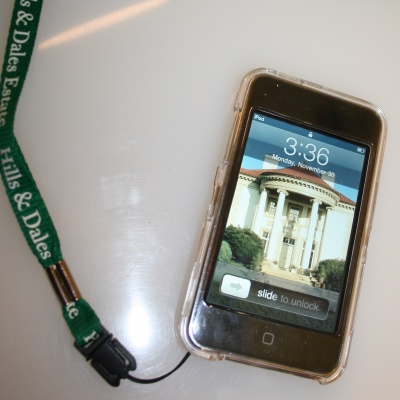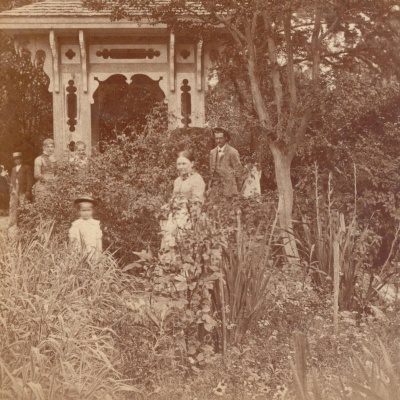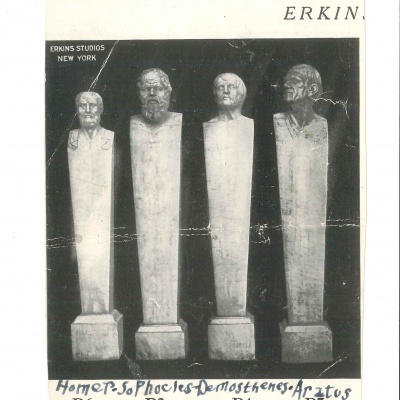Becoming Hills & Dales

It is an interesting term, raison d’être. Translating the French literally it becomes “reason to be”, denoting the reason for the existence of something or someone. Follow this train of thought and apply it to the estate’s beginning, and it can be said that the historic garden ensconced within the landscape at Hills & Dales is its raison d’être. In other words, what truly propelled Fuller Callaway Sr to purchase this property and ultimately build a home on it is the fact that the Ferrell’s garden was here. The story of how Mr. Callaway grew up knowing Sarah Ferrell and loving her garden has likely been told no better than in the chapter on Hills & Dales in Buck and Carol Melton’s biography, Fuller E. Callaway: Portrait of a New South Citizen. In it, the reader is eloquently persuaded of his connection to Mrs. Ferrell’s intricate creation and the seeming inevitability that he would be its savior. The following excerpts have been selected to tease this tale a bit more and widen the view into our fortuitous history.
‘Fine houses very often have fine gardens to go with them, and Hills and Dales, from the beginning a very fine house, was no exception. But in one way it was definitely exceptional. Rather than the gardens being designed for and built around the house, as is usual, Callaway had his house designed and built for the garden. This garden, nearly seventy years old by the time Callaway acquired them and at least as fine as the house he built, is where the story of Hills & Dales truly begins…
From the beginning of his life, Fuller, somewhat like Sarah, seemed drawn to flowers. As a mill owner he provided both flowering plants and vegetable plants to his workers free of charge, encouraging mill operatives to plant flowers both indoors and out, awarding prizes to employees who produced the prettiest or most improved plants, gardens and yards. As a youth he spent a great deal of time in Sarah’s garden where he became a great favorite of hers. Perhaps he somehow reminded her of her own deceased son Palmon Ernest Ferrell. As an adult, Callaway claimed that he loved the garden more than anyone except for the Ferrells themselves…
One day around the turn of the century, with Sarah now well into her 80s, Callaway was showing some out-of-town customers around the gardens. Sarah was busy planting flowers, and he stopped to chat with her. “I want you to have this garden,” she suddenly told him as they conversed. “You are the only one that loves it enough to keep it going.” Callaway would remember that conversation.
In 1903 Sarah Coleman Ferrell died at the age of eighty-six. Five years later Blount Ferrell, aged ninety-two, followed her. The couple’s only surviving child was almost seventy, and since he was unable to take on the responsibility for the labor-intensive garden, the property rapidly went downhill.
In December 1911, the entire estate was auctioned off… Fuller Callaway bid on it and bought it for $8,150… Precisely when the Callaways got the idea of building a new home next to Ferrell Gardens is uncertain… After taking possession, his first actions related to the garden itself, and perhaps even to farming. In 1913 he commissioned a study of the garden, and it was apparently around this time that he put [his brother] Pope in charge of managing the estate, complete with a crew of laborers and a foreman working under him… Not until January 1914, fully two years after his initial purchase, did Callaway publicly announce plans to build a new home adjacent to the gardens as well as hiring an architectural firm. The agency he chose was… Hentz and Reid, of Macon and Atlanta…
Though [Neel] Reid was a product of the Southern piedmont, his education was cosmopolitan, and this, too, influenced his work…
The designs that Reid submitted for Hills & Dales reflected his varied background, but the gardens, of course, were perhaps the most important influence. The terraces, perhaps originally planted with cotton before Sarah turned them into something reminiscent of the Renaissance, suggested a fusion of Old South and Tuscan villa. Reid capitalized on the combination, referring to Hills and Dales as “Georgian Italian”…
Reid… set about designing a house that would fit in not only with Ferrell Gardens, and not only with the south, but with the lives of Fuller and Ida Callaway…
What arose on top of the hill to crown the garden terraces was an edifice of white stucco trimmed with stone, boasting a red pantile roof. The symmetrical southern façade…was topped with a pediment supported by four ionic pilasters. Through French doors one stepped directly from the… living hall — the house’s largest room — into the garden. On the center of the upper terrace the architects added a large fountain to further tie in the house and the gardens.’
The chapter goes on to describe the completion of the home in more detail, and then finally, after two years of construction work, the celebratory day that the couple moved in — June 15, 1916. Near this section’s end, the authors note that in the ensuing years, “Hills and Dales became a Callaway icon” and that the gardens were kept “open to the public as Sarah and Blount had done.” It may not be a foregone conclusion that the practice of sharing this beautiful place anticipated its ultimate evolution into the public house and garden museum that it is today; however, it most certainly set a compelling precedent for this sequel that serves to preserve the lovely home and its surrounding verdant terraces for generations to come. Vive le jardin! Vive Hills & Dales Estate!

Fuller Callaway Sr in historic Ferrell Garden with newly planted boxwood c 1920. Photo courtesy Troup County Archives. |

Fuller Callaway Sr walking in Ferrell Garden c 1917. Photo Courtesy Troup County Archives. |


